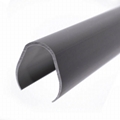The process of profile extrusion involves several stages, starting with the raw material. The raw material, which is usually in the form of pellets or powder, is fed into a hopper, where it is heated to a specific temperature. Next, the material is forced through a die, which is a metal plate with a hole in it.

The die determines the shape and size of the extruded plastic. As the plastic passes through the die, it cools and solidifies into a continuous shape. The process can be used to create a range of profile shapes, including tubes, pipes, and flat sheets.
One of the significant advantages of profile extrusion is that it can produce plastic shapes with a consistent cross-section over long lengths. This is particularly useful in applications where the plastic needs to maintain a specific shape to serve its intended purpose, such as a pipe or a conduit. Additionally, profile extrusion allows for the creation of complex shapes with varying thicknesses and wall sections.
Another benefit of profile extrusion is that it can be used with a variety of plastic materials, including PVC, Polyethylene, and Polypropylene. Each material has its unique properties, making it suitable for various applications. For example, PVC is commonly used in pipes and electrical conduit, while Polyethylene is used in food packaging and agriculture applications.
The automotive industry is one of the industries that extensively uses profile extrusion. Plastic components that are used in cars, such as interior trim and exterior molding, are often made using this process. The process allows manufacturers to create a wide range of plastic components in various shapes and sizes, reducing the need for tooling changes.
The construction industry is another industry that uses profile extrusion heavily. Plastic components such as window frames, door frames, and siding are commonly made using this process. The process allows manufacturers to create components with a consistent cross-section, reducing installation time and improving the accuracy of the finished product.
Lastly, profile extrusion finds a wide range of applications in the consumer goods industry. Plastic components such as tubing and piping for appliances and recreational equipment are commonly made using this process. Additionally, the process can be used to create complex shapes that are used in household items such as shower curtains and blinds.
In conclusion, profile extrusion is a vital part of the plastic manufacturing industry. Its versatility and ability to create plastic components with a consistent cross-section make it a popular choice in many industries. The process allows manufacturers to create a wide range of shapes and sizes with varying wall thicknesses and is used in applications that range from automotive to consumer goods. Overall, profile extrusion is a valuable manufacturing process that will continue to play a significant role in the future of plastics manufacturing.